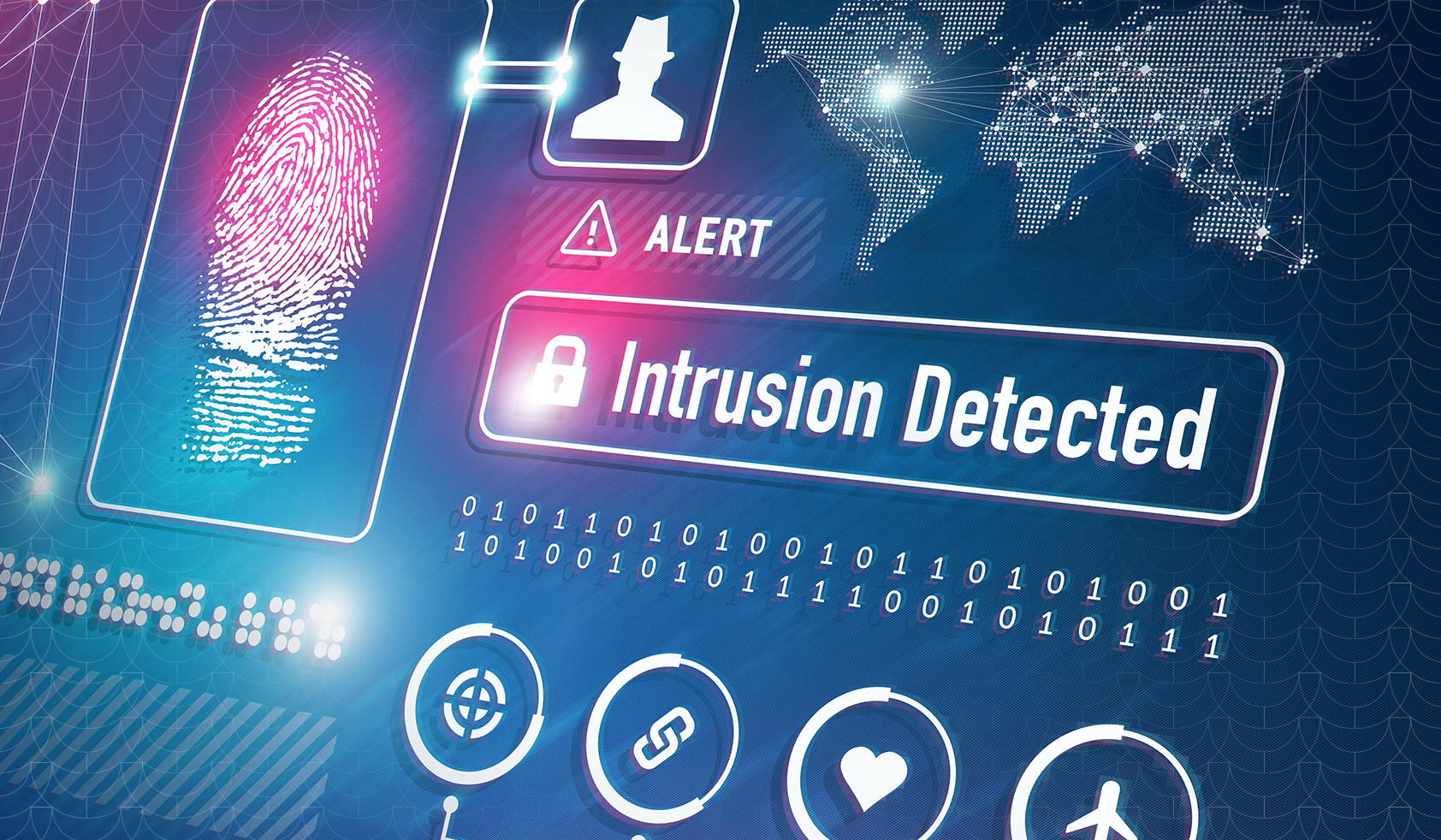Picture your business safely locked up for the night. Then, a movement, sound or unexpected signal pops up. How would you know? How quickly could you pinpoint the threat and react?
The risk of unauthorized entry, theft, and sabotage are top of mind for many business owners, and locks and cameras rarely feel like enough. A proactive approach keeps your premises, assets, and people safe.
Intrusion detection systems are a vital part of this proactive approach. They go beyond simple alarms, with advanced detection capabilities that alert you to potential threats long before they escalate.
This guide will walk you through the world of intrusion detection, what it is, the types available, and what they do. Then, we'll explore real-life examples to understand how intrusion detection systems can help your business.
What is an intrusion detection system?
An intrusion detection system monitors a physical space for movement, noises, or other violations. If it detects something, it produces an alert.
It’s an invisible fence that's always ready to signal when something isn't right, acting as a critical component of a layered security strategy.
You can’t prevent every threat, but an early warning about the ones that do occur can make all the difference.
Common types of intrusion detection systems
Intrusion detection systems come in all shapes and sizes to meet the needs of different businesses. Which would best suit your setup?
Network-based IDS (NIDS) vs. host-based IDS (HIDS)
For focused on cyber threats, these concepts are relevant for integrated physical security. A NIDS monitors network traffic for suspicious activity, such as attempts to disable security cameras or access control systems.
A HIDS monitors individual devices or servers for changes that might indicate a breach, often on devices within a physically secured area.
Signature-based vs. anomaly-based detection
Signature-based detection spots intrusions by looking for patterns that match known threats or behaviors. For example, the unique vibration pattern of a ladder being placed against a fence or the sound pattern of glass shattering.
Anomaly-based detection establishes a baseline of normal activity and flags anything out of line. If a door that's usually closed at 20:00 suddenly opens, an anomaly-based system would alert you.
Physical perimeter sensors
These are crucial for detecting intrusions at the edge of your property. They include:
- Magnetic contacts (door/window sensors): Simple sensors that detect when a door or window is opened.
- Fence sensors: Detect cutting, climbing, or vibrations on perimeter fences.
- Ground sensors: Buried sensors that detect footsteps or vehicles.
- Passive infrared sensors: Detect changes in heat, often used for motion detection.
- Active infrared sensors: Create an invisible tripwire that, when broken, triggers an alarm.
- Microwave barriers: An electromagnetic field between two points that, if broken, triggers an alarm. These are often used for larger outdoor perimeters.
- Vibration sensors: Attached to walls, fences, or windows, they detect unusual vibrations caused by forced entry or impact.
- Glass break detectors: Audio sensors that recognize the specific sound frequencies of breaking glass.
- Dual-technology sensors: Combining passive infrared sensors with microwave or ultrasonic detection to reduce false alarms.
Four real-life examples of intrusion detection systems
To understand how these systems operate and combine in practice, let’s look at some real-world use cases.
A high-security data center
The Challenge: Data centers house critical digital assets and intellectual property, making them prime targets for intrusion, theft, or sabotage. Unauthorized access could lead to costly breaches and downtime.
The Solution: A data center needs a multi-layered solution.
- The outer perimeter is secured with fiber-optic fence sensors that detect attempts to cut or climb, integrated with microwave barriers for open spaces around the facility.
- Inside the perimeter, ground sensors detect footsteps leading to the building.
- Entry points are protected by magnetic door contacts and motion detectors in corridors.
- Biometric access control systems at server room doors act as another layer.
- Vibration sensors on server racks check for tampering.
How it works in practice: If an intruder attempts to breach the fence, the fiber-optic sensors trigger an alert, simultaneously activating pan-tilt-zoom security cameras. This immediate visual verification allows security operators to assess the threat and dispatch guards before the intruder even reaches the building.
Return on investment: Preventing potentially catastrophic data breaches and service outages, safeguarding millions of dollars in assets and reputation.
The Acre way: Acre provides advanced intrusion panels for a centralized view of your setup, integrated with sensors for rapid alert management.
A large retail store
The Challenge: Retail stores are vulnerable to after-hours break-ins, organized crime, and internal theft. Large spaces and multiple entry points pose major detection challenges.
The IDS Solution: Beyond typical alarm systems, stores use intrusion detection systems primarily for after-hours protection.
- Motion detectors are strategically placed throughout the store.
- Glass break detectors protect display windows and doors.
- All entry and exit points, including loading docks and emergency exits, are secured with magnetic door contacts.
- Some high-value display cases have vibration sensors.
How it works in practice: If a window is smashed after closing hours, the glass break detector immediately sends an alert to a central monitoring station. Simultaneously, interior motion detectors confirm the intrusion. This rapid notification allows law enforcement to arrive quickly, catching perpetrators in the act and minimizing losses.
Return on investment: Significantly reducing inventory loss, lowering insurance premiums, and preventing costly business interruptions.
The Acre way: Acre's intrusion detection systems offer robust panels and a wide range of reliable sensors, perfectly suited to monitoring large retail spaces. They integrate with existing alarm monitoring services for comprehensive protection.
A pharmaceutical manufacturing plant
The Challenge: Manufacturing plants often have vast, complex layouts, hazardous zones, expensive machinery, and valuable raw materials. Few more so than the pharmaceutical industry. Protecting these assets from intrusion while ensuring employee safety is a real challenge.
The IDS Solution: A multi-layered solution is essential in these environments.
- Perimeter fence sensors for the entire property, combined with microwave barriers or active infrared beams across open yards to detect large objects or vehicles.
- Inside, specific areas like control rooms or storage for valuable materials use vibration sensors on walls and safes.
- Entry to hazardous zones requires a combination of biometric access control for authorized personnel and motion detection to ensure no one is there who shouldn’t be.
How it works in practice: An unusual vibration on a perimeter wall, perhaps from an attempt to cut through a fence, triggers an alarm and sends an alert to the security control room. Personnel review live video feeds from nearby cameras to confirm the threat and respond accordingly, dispatching security or contacting local authorities.
Return on investment: Preventing costly damage or theft, safeguarding valuable intellectual property, and maintaining uninterrupted output.
The Acre way: Acre provides flexible and scalable intruder detection systems fit for the complex security needs of industrial manufacturing environments. With diverse sensor types and powerful management software, the solutions are ideal for large-scale deployments.
A power substation
The Challenge: These vital facilities are prime targets for sabotage or even terrorism. Any disruption could have widespread and severe consequences at scale. Rapid response is paramount.
The IDS Solution: Critical infrastructure relies on layers of intrusion detection.
- The outer perimeter uses a combination of fiber-optic fence sensors, microwave detection, and thermal cameras to detect long-range human presence, day or night.
- Internal security includes motion sensors in control rooms and chemical storage areas.
- Integration with advanced video analytics uses AI to distinguish between intruders and animals or environmental factors.
How it works in practice: A thermal camera detects a human figure approaching a restricted substation. The system recognizes that no authorized access holder is scheduled for that area, triggering a high-priority alert to the national security center and local response teams. The system tracks the intruder's movement across multiple cameras, providing real-time intelligence to responders.
Return on investment: Preventing disruption to public services, environmental disasters, and national security threats, protecting lives and societal functions.
The Acre way: Acre's focus on robust security systems provides the intrusion detection capabilities for such sensitive sites. You can count on reliable detection and integration for comprehensive monitoring and rapid response.
Why real-world examples matter
Understanding what an intrusion detection system is in theory is one thing, but seeing how these systems work in real-life provides invaluable insight. Learning from successful applications helps organizations understand which solution might be a good fit for your unique risks and layout. It’s a starting point to work out how to deploy intrusion detection effectively, and begin to calculate the potential return on investment.
What these examples reveal about modern threat detection
These real-world examples highlight several key trends and insights within modern intrusion detection:
Layered security: No single sensor type provides complete protection. Effective intrusion detection relies on multiple layers of security, from the perimeter to the most sensitive interior spaces.
Integration: The strength of an intrusion detection system comes from its ability to integrate with other systems like access control, video surveillance, and alarm monitoring. This enables faster verification of threats and improves response coordination.
Early warning: Modern systems detect intrusions at the earliest possible stage, before a physical breach even occurs. This means security teams have the maximum time to react.
Fewer false alarms: Advancements in sensor technology, AI, and integration capabilities significantly reduce false alarms. Security personnel only respond to genuine threats.
Made to measure: Intrusion detection must be tailored to the specific environment. What works for a data center's perimeter might be overkill or even ineffective for an office interior.
Rapid response: By providing immediate and accurate alerts, intrusion detection cuts down on response times. Security teams can address threats quickly and minimize potential damage or loss.
How Acre Intrusion supports your organization
At Acre, we understand that protecting your physical assets and personnel is paramount. Our intrusion detection systems provide the security you need in a flexible and tailored way.
With high-performance technology driving our systems, we can provide rapid-response and accurate detection capabilities. Our advanced panels and intuitive software make it easy to stay on top of security. Security only works when it’s unified, so, perhaps the most important thing we can note is that our solutions integrate seamlessly with other systems.
Whether you're safeguarding a sprawling industrial complex, a sensitive data center, or a busy commercial office building, Acre offers IDS that scale and adapt to your needs.
Learn more about Acre's advanced intruder detection systems and how they can make your premises safer.
Stopping threats before they occur
Your people, premises, and assets are the foundation of your business. They deserve protection.
The right intrusion detection system protects these vital components of your business, providing crucial early warnings that enable swift responses to potential risks. It’s hard to imagine a modern physical security strategy that doesn’t include IDS.
The real-world examples we've explored highlight the importance and adaptability of intrusion detection across diverse industries. A layered approach to security, with seamless integrations and interaction, can make even the most sensitive locations secure.
Contact Acre Security today to discuss your intrusion detection needs and unlock unparalleled protection for your premises.





